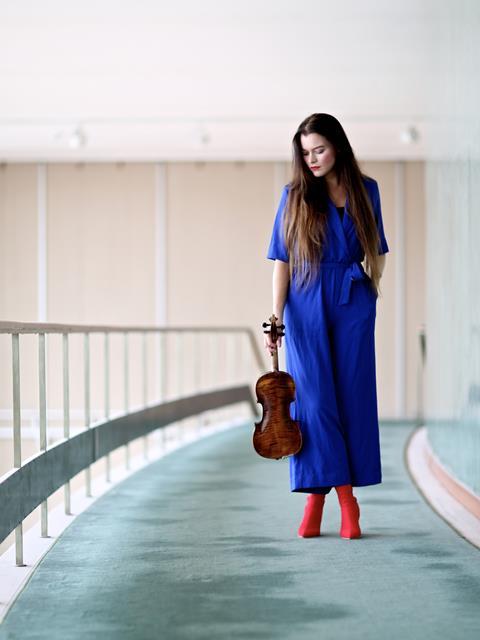With the release of her debut single ‘To Grandpa’, the violinist hopes more instrumentalists will experiment with composition and improvisation in their playing

Discover more Featured Stories like this in The Strad Playing Hub
When I was six years old, I saw my first classical performance, Vivaldi’s Four Seasons, and I knew immediately I wanted to play. A few months into my violin studies, I started to write music. I began to compose.
Then, suddenly, at twelve, I stopped writing. Why? I think it’s because all my instruction was about following strict rules—playing pieces as they’ve been played for hundreds of years. For the next 14 years, I studied, played, and performed—as a solo violinist, in orchestras and quartets. Then when I was 26, I suddenly began to hear new melodies in my head, and it changed my whole relationship to music.
Of course, it’s very personal to play music. To compose, though, you show your soul in a new way—and your soul shows itself to you.
Composition has become essential to my life as a violinist, and it makes me want to encourage other musicians to try. Finding my own voice has unlocked new, deeper relationships to the soul of music written by others. If you’re curious to experiment, you can start with these four principles: inspiration, collaboration, improvisation, and experience.
It begins with inspiration from composers you admire—playing Bach sonatas, say, or Mozart concertos. In older times, cadenzas to such pieces were inspired by the written piece—but made up by the performer in the style of the piece just performed.
This is a terrific way to start—make your own cadenza, following the spirit of a piece you already love. Jazz musicians do that all the time, and it’s one way into improvisation.
These days, I make improvisation a regular part of my practice day, I do scales. I play etudes. And I improvise every day, trying to play my emotions. Often, the key to improvisation—especially if it’s new to you—is to find a framework. The cadenza, for example, is creatively constrained both by time (it’s just a few minutes) and by the style and tradition of the piece it ends.
You might choose a style like baroque or romantic and create something new in that tradition. Or you might choose a certain number of bars to play freely. You could also play a simple theme or melody, and then experiment with varieties. This is the root of many profound pieces, like Paganini’s Caprice No. 24 and Arvo Part’s Fratres.
My favourite call-and-response improvisation is in collaboration. The key is to find someone you feel very safe with, and to warmly agree to avoid judgement. In writers’ rooms for television shows, a common rule is to never say ’No’ or ‘but’ after another person’s idea, but only ’Yes … and.’ This spirit can apply to musical exchange, too.
It’s beautiful when it happens, and rare. One of my earliest collaborators saw me so deeply and believed in me so fully that I developed a whole new confidence in my style and my composition.
Read: 10 tips for improvising on a stringed instrument
Read: Courage before confidence: the benefits of improvising for classical musicians
Then I started writing with different people. Also I wrote alone. Indeed, I think there are times to plumb your own experience, and to ask what you, and only you, might have to say—or might need to say.
Several years ago, I lost my best friend. His name was Einar Falk. Before he got sick, he was wise, charismatic, and exceedingly clever and funny. His bright blue eyes lit up every room, every conversation—with grocery store clerks, with his colleagues, and with me, his grand-daughter.
About a year after my grandpa died, I wrote a piece for him. I felt a grief that was almost unbearable, but I also felt, with music, I could make space within the grief. After I recorded the piece with the Norwegian Radio Orchestra, I learned from listeners’ responses that my own space within those hard feelings made space for others to feel their feelings, too.
It’s so surprising, and wonderful, to make something beautiful out of pain. This piece really did feel like the sound of my soul, and I think that’s true whenever we make something of our own.
I feel this practice is especially important for women, because until recently, we weren’t even allowed to play in orchestras. We were certainly discouraged from creating. Fanny Mendelssohn grew up studying music with her brother, but their father told her that while music could be Felix’s career, ’for you, it can and must only be an ornament, never the root of your being and doing.’
Like Fanny, many of us have something to say. But even if we don’t have ambitions to make a career of composition, I’ve seen how it can make us better performers. Writing has made me feel more open—also more connected to tradition. I feel more committed—also more flexible. I’m freer in how I relate to my instrument and even to myself.
Watch the video of To Grandpa below. The video was made by Norwegian photo artist Ingvild Aksnes Rebnord:
Watch: Video premiere: Elisabeth Turmo performs Ysaÿe Sonata no.3
Read: Forgotten in HIStory: shining a light on female composers through the ages
Read: ‘Her Strad sounded like a husky voice with a rich timbre’: composer Solveig Sørbø
Read more Featured Stories like this in The Strad Playing Hub




































No comments yet